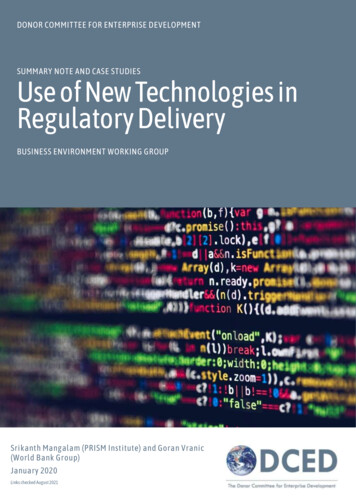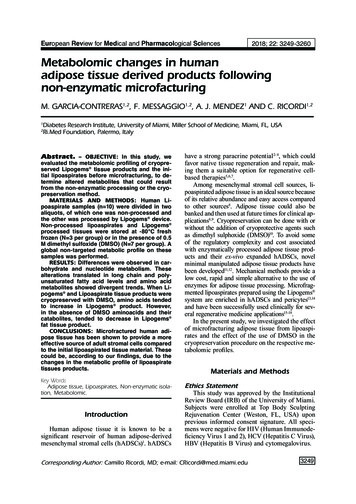
Transcription
DONOR COMMITTEE FOR ENTERPRISE DEVELOPMENTDONOR COMMITTEE FOR ENTERPRISE DEVELOPMENTSUMMARY NOTE AND CASE STUDIESUse of New Technologies inRegulatory DeliveryBUSINESS ENVIRONMENT WORKING GROUPSrikanth Mangalam (PRISM Institute) and Goran Vranic(World Bank Group)January 2020Links checked August 2021i
DONOR COMMITTEE FOR ENTERPRISE DEVELOPMENTUse of New Technologies in Regulatory DeliveryBusiness Environment Working GroupDonor Committee for Enterprise Development: www.enterprise-development.orgCitation: PRISM Institute and World Bank Group (2020) ‘Use of New Technologies in Regulatory Delivery,Summary Note and Case Studies, Donor Committee for Enterprise Development, Cambridge, UKAcknowledgementsThis study was commissioned on behalf of the Business Environment Working Group (BEWG) of the DonorCommittee for Enterprise Development (DCED) and made possible through funding by the GermanDevelopment Cooperation through the Deutsche Gesellschaft für Internationale Zusammenarbeit (GIZ). Theresearch and preparation of the guidance note and case studies was conducted by Srikanth Mangalam (PRISMInstitute), who was the primary author and Goran Vranic (World Bank Group) who was co-author on thereport. Sincere acknowledgements are due to Stefanie Springorum (GIZ) and Andreja Marusic (World Bank) fortheir continued support and guidance, as well as Rainer Engels (GIZ) and Martin Weidner (GIZ) for theircontributions. Gratitude is also expressed to Vasumathi Srikanth, Prism Institute, for providing editorialsupport.We thank the following experts for supporting the research effort and/or peer-reviewing the note and casestudies: Jim Varghese (Government of Queensland), Bruce Muirhead (Mindhive Inc.), Patrick McLaughlin(George Mason University, USA), Andrea Bruce, Claire Barnett (Ontario Cabinet Office), Julie Nind(Government of New Zealand), Ingmar Vali, Tambet Artma (Centre of Registers and Information Systems ofEstonia), Abraham van Poortvliet (Technical Safety BC), Nick Malyshev (OECD), Jon Elliot (UK Government),Martin Weidner, Rainer Engels, Christian Luy (GIZ), Pradeep Valsangkar, Shashank Ojha, Prasanna Lal Das, andLars Grava (World Bank Group).This material has been prepared for discussion purposes only. As such, the material should not be regarded asincorporating legal or investment advice, or providing any recommendation regarding its suitability for yourpurposes. Conclusions expressed in this report do not necessarily reflect the views of the DCED or its members.
DONOR COMMITTEE FOR ENTERPRISE DEVELOPMENTExecutive summaryThere is growing evidence to suggest that the technological advancements of the 21 st century havehad profound implications for governments, including many benefits but also heightenedcomplexity and challenges. Specifically, while digital technologies have already disrupted theBusiness-to-Business (B2B) and Business-to-Customer (B2C) spaces, policy makers alike are yet tounderstand the underlying benefits, opportunities and challenges in the Government-to-Business(G2B) domain. Being a smarter government requires a more forward-thinking approach to the useand integration of information, technology, and innovation in the activities of governing anddelivering services (Ramon Gil-Garcia, 2014).Rulemaking is generally understood as the process by which regulations are created andpromulgated by governments and/or authorities with the powers to make regulations. RegulatoryDelivery, on the other hand, is defined as the way that regulatory agencies operate in practice toachieve the intended outcomes of regulations (Russell and Hodges, 2019). Rulemaking andRegulatory Delivery are the two key components of a regulatory system that help render statutorydecisions and deliver services provided to citizens and businesses by governmental agencies and/orindependent regulators. With digital technologies such as Artificial Intelligence (AI) transformingbusinesses and societies, regulatory delivery needs to evolve as well especially through theadoption of such technologies to make a balance between burden reduction and protection ofpublic and consumer interest in the new digital era (OECD, 2019). AI-enabled solutions, forexample, can not only help regulated parties such as businesses demonstrate compliance, they canalso assist regulators in allocating resources efficiently and obtaining results that demonstratemeaningful outcomes. They enable smarter regulatory oversight activities such as risk-basedtargeting by providing information and knowledge that would allow for proactive actions andresponse.This study, commissioned by GIZ and World Bank Group on behalf of the Business EnvironmentWorking Group of the Donor Committee for Enterprise Development (DCED) contributes newknowledge including progress being made in the G2B applications of emerging technologies andthat builds on more recent studies by organizations including The World Bank Group1, and PrismInstitute2. Specifically, this study contributes new knowledge to answering the following questions:1. How are innovative technologies influencing regulatory rulemaking and regulatory deliverymodels?1Internet of Things – The New Government to Business Platform2Risk Based Regulatory Delivery – Review and Toolkit of Modern Practicesi
DONOR COMMITTEE FOR ENTERPRISE DEVELOPMENT2. What are the prerequisites regulators have put in place to apply these technologies?3. How can these technologies support achieving investment climate reform objectives?4. What are the risks in the use of the technologies and how are they mitigated?A combination of an initial analysis of over 50 emerging practices in the use of artificial intelligenceand other emerging technologies across the different stages of rulemaking and regulatory deliveryacross 5 continents, and a detailed analysis across six jurisdictions (Australia, USA, Estonia, NewZealand, India and Canada), led to the findings which are summarized later in the Conclusionssection. The case studies also provide valuable information supporting the design of a basicmaturity model that can be used by practitioners, particularly in developing countries, to guide theimplementation, monitoring and benchmarking of these technology applications in rulemaking andregulatory delivery activities. The maturity model, while being a new contribution to literature inthis area, should be considered as a work in progress that can be enhanced continually based onevolutions in technology and their applications across the regulatory processes.ii
DONOR COMMITTEE FOR ENTERPRISE DEVELOPMENTTABLE OF CONTENTS1.INTRODUCTION TO CASE STUDIES . 32.DESCRIPTION OF MATURITY MODEL . 62.1 DESCRIPTION OF CATEGORIES . 73.CONCLUSIONS. 94.BIBLIOGRAPHY . 12ANNEX A. DETAILED REVIEW OF SELECTED CASE STUDIES . 13A1: AUSTRALIAN CASE STUDY . 13A2: USA CASE STUDY . 16A3: ESTONIA CASE STUDY . 19A4: NEW ZEALAND CASE STUDY . 25A5: INDIA CASE STUDY . 31A6: CANADA CASE STUDY . 35ANNEX B. INDEX: ORIGINAL LIST OF CASE STUDIES . 40ANNEX C. SHORT DESCRIPTION OF CASE STUDIES . 44I.II.III.DEVELOPMENT OF REGULATIONS . 44REGULATORY/SERVICE DELIVERY . 46MONITORING, REPORTING AND FEEDBACK . 58List of Tables and FiguresFIGURE 1: REGULATORY PROCESSES. 3FIGURE 2: TECHNOLOGY APPLICATIONS FOR REGULATORY DELIVERY . 4FIGURE 3: ILLUSTRATION OF MATURITY MODEL . 6FIGURE 4: IMPLEMENTATION OF CROWDSOURCING IN RULEMAKING . 14FIGURE 5: REGDATA: REGULATORY RESTRICTIONS BY AGENCY AND INDUSTRY . 18FIGURE 6: ESTONIA RIK – AI FOR COMPANY NAME SELECTION . 23FIGURE 7: NEW ZEALAND BETTER FOR BUSINESS (B4B) PROGRAMME . 25FIGURE 8: REGULATORY REQUIREMENTS FOR EXPORTING HONEY FROM NEW ZEALAND . 26FIGURE 9: “TAI” DIGITAL ASSISTANT/CHATBOT. 27FIGURE 10: AP INTEGRATED CENTRALISED ERP SYSTEM . 32FIGURE 11: E-GOVERNMENT CORE PLATFORM . 35FIGURE 12: CASE STUDIES OF EMERGING TECHNOLOGY IN REGULATORY LIFE CYCLE – GEOGRAPHIC VIEW. 40TABLE 1: SUMMARY OF SELECTED CASE STUDIES . 5TABLE 2: EMERGING TECHNOLOGIES IN REGULATORY LIFE CYCLE – CASE STUDIES. 411
DONOR COMMITTEE FOR ENTERPRISE DEVELOPMENTList of AcronymsAIArtificial ConsumerB4BBetter for Business (Government of New Zealand)BEWGBusiness Environment Working GroupCFRCommunity of Federal Regulators (Canada)CIOChief Information OfficerDCEDDonor Committee for Enterprise DevelopmentG2BGovernment to BusinessG2CGovernment to ConsumerG2GGovernment to GovernmentGISGeographic Information SystemGIZDeutsche Gesellschaft für Internationale Zusammenarbeit GmbHGNUFree Unix Style Operating SystemIoTInternet of ThingsMLMachine learningNAICSNorth American Industrial Classification SystemOECDOrganization for Economic Cooperation and DevelopmentOpenVASOpen Vulnerability Assessment SystemPrismInstituteRACQPublic Risk Management InstituteRIKEstonian Centre of Registers and Information SystemsULBUrban Local Bodies (Andhra Pradesh, India)UQUniversity of QueenslandUS CFRUnited States Code of Federal RegulationsRoyal Automobile Club of Queensland2
DONOR COMMITTEE FOR ENTERPRISE DEVELOPMENT1.Introduction to Case StudiesThis Note provides highlights of a study on the use of artificial intelligence and other emergingtechnologies across the different stages of rulemaking and regulatory delivery by analyzing theirapplication across jurisdictions including Australia, USA, Estonia, New Zealand, India and Canada.The typical stages of a regulatory lifecycle consist of the following at a minimum: Development of regulations or rulemaking; Regulatory management including regulatory delivery; and Monitoring and Feedback.The typical processes representing best practices that support these various stages of a regulatorylifecycle (OECD 2010), can be captured under the categories illustrated in Figure 1 below.Figure 1: Regulatory ProcessesRulemaking Identification andprediction of publicpolicy issues Regulatory stock scan Ex-ante regulatoryassessment Mapping of regulatoryinstruments withpolicy objectives Stakeholderconsultation (e.g.,crowdsourcing) Public-private dialogueincluding genderrepresentationRegulatoryDelivery Investment facilitation Business registration Permits and approvals Land and propertyregistration Inspections andenforcementMonitoring andFeedback Performancemanagement Stakeholder/publicfeedback Program evaluation(including ex postevaluations) Risk and complianceeducation Access to courts,alternate disputeresolution, etc. Regulatory cooperationSource: Authors3
DONOR COMMITTEE FOR ENTERPRISE DEVELOPMENTAI, the use of algorithms, and the growing uptake of open data, as well as social media, enableregulators to collect timely information, conduct analysis and engage with stakeholders whendeveloping coherent policies. Digital technologies can also replace or complement traditionalcompliance enforcement methods and support policy evaluation. These technologies described inFigure 2 below can help in collecting, aggregating and analyzing large volumes of data (Hu et al,2014) to facilitate faster, more accurate and more reliable means of executing activities designedacross the various stages of life cycle.Figure 2: Technology Applications for Regulatory DeliveryDataCollection Social media tools Basic digital tools(tags, scans, RFIDs,etc.) Real-timetechnologies(Internet of Things,Drones, Robotics,etc.)DataTransmission Exchange of businessinformation (e.g.,XBRL) BlockchainDataAnalysis Big Data Artificial Intelligenceo Machine Learningo Natural LanguageProcessing/Generationo Machine/ComputerVision Remote sensing CrowdsourcingSource: AuthorsOver 60 cases spanning across Americas, Asia, Europe and Australia were initially identified thatcovered technology applications across the different stages of lifecycle. These cases (see Annex B)largely represented applications that: Targeted Service delivery with “Registrations” (Businesses, Licensing, Land Titles etc.),“Access to Services” and ‘Surveillance and inspections”; Used Artificial intelligence, machine learning and/or natural language processing as the mostpreferred means; and Also covered real-time technology (IoT, remote sensing etc.), social media andcrowdsourcing tools, and blockchain technology across the regulatory cycle.Based on this initial information, six of these cases were selected for further analysis. The intentbehind this approach was to learn from the developments of advanced jurisdictions with a potentialto be replicated to developing environments (such as, transitional economies, and fragile, conflictedand volatile areas). The detailed analysis was conducted using a combination of questionnaires,4
DONOR COMMITTEE FOR ENTERPRISE DEVELOPMENTtelephone interviews and documentary research. The questionnaire itself was designed based on aninitial maturity model framework that was subsequently validated through the case studies. The sixcase studies are shown in Table 1 below.Table 1: Summary of Selected Case StudiesCountryAustraliaUSA/CanadaEstoniaNew ZealandIndiaCanadaParticipatingJurisdictionLevel of Government Regulatory andDepartment ofTransport andMain RoadsStateIdentification ofPublic Policy IssuesCrowdsourcingIn ProductionMultipleFederal (US), andProvincial (Ontario,Canada)Regulatory StockScanMachine LearningIn ProductionMinistry of JusticeNationalBusinessRegistrationArtificial IntelligencePilotMinistry of BusinessInnovation andEmploymentCentralComplianceEducationArtificial IntelligencePilotGovernment ofAndhra PradeshStateLand and PropertyRegistrationRemote Sensing,Internet of Things,Artificial IntelligenceIn ProductionTechnical Safety BCProvincial (BritishColumbia)Risk-basedInspectionsMachine LearningIn Production5
DONOR COMMITTEE FOR ENTERPRISE DEVELOPMENT2.Description of Maturity ModelA basic maturity model using generally described principles3 was developed to help determine thepriority of specific elements required to implement emerging technologies designed for specificregulatory processes. In addition to establishing the priorities, the model is also intended to help mapthe maturity levels for each of these steps in order to monitor progress. For the purposes of thisstudy, the maturity model was more used to determine the relevance and applicability of thecategories and less so to characterize the maturity levels for the selected case studies.The maturity model was initially developed using four main model categories, Policy Considerations,Institutional Arrangements, Technology Implementation, and Operating Model and Sustainability(Figure 3).Figure 3: Illustration of Maturity ModelModel CategoryMaturity level 1Maturity level 2Initial (Concept)PilotedMaturity level 3Partially Scaled,Implemented andStandardizedMaturity level 4Fully Scaled,Implemented andStandardizedMaturity level 5Optimized withContinuousImprovementI. PolicyConsiderationsII. InstitutionalArrangementsThe categories and individual elements within each category are described belowIII. TechnologyImplementationIV. Operating Modeland SustainabilityAs part of this study, professional judgement was used to assign maturity levels against each categoryacross the case studies. Follow-up research is required to further analyse and identify the parametersthat would better define the maturity levels.3https://en.wikipedia.org/wiki/Maturity model6
DONOR COMMITTEE FOR ENTERPRISE DEVELOPMENT2.1 Description of CategoriesPolicy ConsiderationsThis model category examines the relevance of and priority of any legal and policy considerationsthat are essential prerequisites to support the application of emerging technologies across regulatoryprocesses. The considerations apply to broad-based government policies, specific laws andregulations that may apply to the governance, use and application of data, and other planningconsiderations. Specifically, the elements addressed under this category include: Regulations (performance-based and not prescriptive, focused on an outcome and riskmanagement) that allow the use of AI and other emerging technologies in rulemaking andregulatory delivery; Policies for using emerging technologies for rulemaking and regulatory delivery; Specific laws/policies that regulate the collection, ownership, sharing, use, privacy, qualityand security of data; Standards developed, adopted and/or used for the use of emerging technologies (e.g.,interoperability framework); Processes for stakeholder consultation and citizen engagement before the use of emergingtechnologies; Gender equity considerations as part of applying emerging technologies (includingeliminating gender bias, Leaving no one behind, and any other discrimination); and Rules/Policies for using sandboxes for pilot testing.Institutional ArrangementsInstitutions embarking on a journey of implementing emerging technologies are required to put inplace arrangements that support the successful implementation of such initiatives. Thesearrangements range from establishing strategies and plans, appropriate institutional andorganizational structures (e.g., inspection coordination bodies), necessary resources and capacity,and private-academic partnerships. Specific elements covered under this category include: Organizational structure including a senior role responsible for the use of innovation/riskmanagement/emerging technologies; Research programs/partnerships (e.g., academic) to facilitate the development and use ofemerging technologies; Recruitment, staffing and training programs and practices, and job descriptions thatrecognize the use of emerging technologies; Private companies/Start-ups to be partners in piloting and implementation (includinginnovative procurement procedures); Procedures to pilot test the use of emerging technologies before implementation; and7
DONOR COMMITTEE FOR ENTERPRISE DEVELOPMENT Methods for measurement of outcomes and indicators to evaluate the effectiveness of theemerging technologies as an alternative to traditional approaches.Technology ImplementationThe feasibility, ease, reliability and effectiveness of the implementation of AI and other technologiesare dependent on some key emerging best practices that reflect both software and hardwareelements including hosting environments and other infrastructure aspects. Some of the elementsthat help address these expectations under this category include: Use of cloud-based technology infrastructure to implement the emerging technologies; Interoperability across the regulatory lifecycle (from business entry, over the operation, toexit, implementing "Once Only" principle); Infrastructure built to international standards and best practices; Specific resources and staffing to manage and maintain the technology infrastructure; Marketplace options for implementing the AI and other emerging technologies; Platforms that support "Open Data"; Partnerships with private sector to provide data using emerging technologies fordemonstrating compliance, and for risk management; and Feedback mechanisms for regulated businesses and the public on the technologyapplications and services provided.Operating Models and SustainabilityOne of the key challenges and gaps identified in previous studies on this topic involve the mosteffective and appropriate operating business models that not only help initial infrastructure costs butalso demonstrate long-term sustainability (e.g., ongoing operation and maintenance). Sustainabilityof such models requires a top-down commitment and alignment with government priorities andpathways for active public-private sector dialogue schemes. Specifically, the following elements arenecessary for long-term sustainability: Alignment of the use of data generated by emerging technologies driven with the broadobjectives of the government typically through government mandates and policy directives; Availability of long-term strategy and sustainable business models; Shared cost of implementation and operation across stakeholders (e.g., subsidised by thegovernment); Incentives for private sector participation (e.g., lower inspections costs, insurance reduction)in emerging technologies; Mechanisms to measure the benefits of the implementation (measured against expectedoutcomes and indicators); and Alternative/contingency plans.8
DONOR COMMITTEE FOR ENTERPRISE DEVELOPMENT3.ConclusionsAn initial assessment of over 50 case studies covering 21 countries/jurisdictions in Asia, Americas,Australia and Europe suggests that a wide range of innovative technologies are being used toenhance the quality of service delivery across regulatory life-cycles. More than 60% of these casestudies have been successfully implemented and the rest are in pilot/proof of concept stages. Adetailed review of six of the 50 case studies using a basic maturity model framework examined thepre-requisites that regulators had to put in place to apply these technologies across four distinctcategories including policy considerations, institutional arrangements, technology implementationand operating models and sustainability.During the review of the six specific case studies, it became obvious that not all the categories and/orspecific questions apply to all the individual cases and they would therefore need to be tailored tospecific elements of the regulatory life cycle and the technologies under consideration. In addition,responses to some of the questions were also dependent on the level of maturity (i.e., status of theimplementation) of the technologies thereby limiting the ability to determine their relativeimportance. The framework also introduced a maturity assessment approach that would helpdetermine the levels at which jurisdictions are and/or need to be to successfully implement thetechnology solutions. However, as the applications were either in the pilot/proof of concept or earlystages of implementation the study was unable to clearly identify the parameters that define thematurity levels and may be covered as part of a future study.Nonetheless, the case studies reveal some key findings that help provide broad-based guidance todeveloping and transitional economies as they evaluate the relevance and applicability of emergingtechnologies as part of their investment climate reform. They include: Recognition that the collection and use of data is the most fundamental element in thetransformation of regulatory processes, because:o Artificial Intelligence and associated applications (Machine Learning, Natural LanguageProcessing), which are increasingly being used across several regulatory processes,require a range of data sources.o Regulators are beginning to recognize the need for timely, reliable data usinginnovative data gathering (e.g., Internet of Things, Remote Sensing) and dataaggregation/transmission (blockchain) technologies as key to supporting AI basedapplications. Technology can significantly enhance the scope of regulatory inspections and enforcementby providing valuable data on compliance and risk and therefore making performance orrisk-based regulations a critical pre-requisite.9
DONOR COMMITTEE FOR ENTERPRISE DEVELOPMENT Regulatory alternatives (e.g., Self or Co-regulations, Regulatory Co-operation) help indesigning timely technology-based responses to disruptive business models coordinatingacross multiple agencies and departments, data sharing, or creating automated responsesto regulatory queries spanning across multiple regulatory domains. Examples include globalsupply chains, online marketplace platforms etc. The establishment of regulation for data collection helps to not only transparently definethe data needs of government but also to mandate its collection, sharing and use. Creatingunique identifiers for core data elements creates the opportunity to map and link severalgovernment to business services including regulatory delivery. Distinct regulatory policies and guidelines are imperative to address issues surrounding dataprivacy, prevention of discrimination and biased algorithms, and ethical considerations. Sandbox environments are a useful means to test a range of aspects including policydevelopment, technology relevance and feasibility, interoperability, costs, and businessmodels. The presence of a senior leadership role with responsibility for research, development,coordination, and implementation of emerging technologies is seen as vital to the success oftheir deployment. An internal team of experts and/or the use of outsourced services ofexpertise have both been used to build and maintain capacity and skills within anorganization. Partnerships with academic and/or research institutions have benefited agencies onmultiple fronts including access to the most modern and innovative solutions, continuity ofsupport and availability of short-term resources such as internships and lower costs forexpertise compared to obtaining prohibitively expensive resources. Cloud based solutions built using open source codes appear to be the most common, costeffective and standardized means of applying technologies such as AI and ML. These alsoensure that the availability of suppliers and experts in the marketplace are adequate andthat issues such as interoperability are addressed. While most governments are moving towards “open data” it is yet unclear if this is alwaysthe most appropriate approach particularly if the data is being sourced from external partiessuch as the private or the regulated sector. Misuse of data (e.g., for enforcement purposes),protection of proprietary information etc. have been raised as risks. Increasingly, regulatory agencies are recruiting data scientists and analysts to form thebackbone of any implementation of such technologies. Procurement processes are ensuring that training modules are an essential component ofany packages provided to regulators from external suppliers. In most cases, governments continue to bear the costs of the research, development andimplementation of emerging technologies. Previous research (World Bank, 2017) suggeststhat such approaches are unsustainable and subject to several political and administrativerisks and that incentives/subsidies should be created for the private sector to participate inand share the burden.10
DONOR COMMITTEE FOR ENTERPRISE DEVELOPMENT The most
Summary Note and Case Studies, Donor Committee for Enterprise Development, Cambridge, UK Acknowledgements This study was commissioned on behalf of the Business Environment Working Group (BEWG) of the Donor Committee for Enterprise Development (DCED) and made possible through funding by the German Development Cooperation through the Deutsche .
![OPTN Policies Effective as of April 28 2022 [9.9A]](/img/32/optn-policies.jpg)









